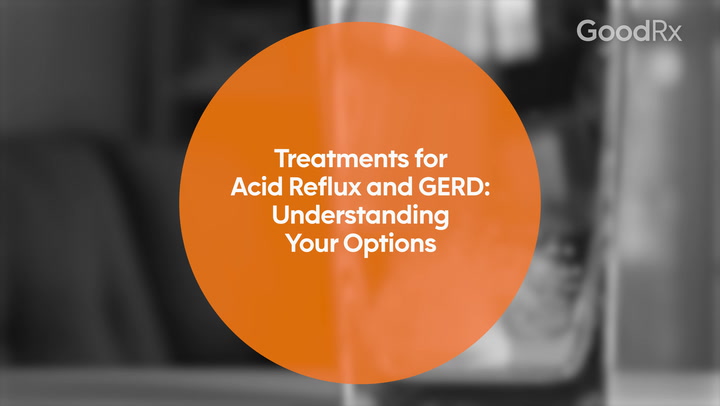
Best Acid Reflux Medicine: Comparing Antacids, H2 Blockers, and Proton Pump Inhibitors
Key takeaways:
Common acid reflux medications include antacids, histamine-2 antagonists (H2 blockers), and proton pump inhibitors (PPIs). Potassium-competitive acid blockers (PCABs) are the newest type of acid reflux medication.
Antacids are best for immediate relief, but aren’t meant for chronic symptoms. H2 blockers work for both occasional and chronic heartburn as well as gastroesophageal reflux disease (GERD). PPIs and PCABs are typically reserved for chronic heartburn and GERD.
There are ways to save on acid reflux medications. Many of them are available as lower-cost generics and have copay savings opportunities. GoodRx can help make your prescription more affordable.
Access savings on related medications
If you've ever felt a burning sensation in your chest after a big meal, you're not alone. More than 60 million Americans deal with heartburn at least once a month. That burning feeling is often a sign of acid reflux — when stomach acid sneaks back up into your esophagus, the tube that connects your mouth and stomach. When acid reflux becomes a regular problem, it may be a sign of something more serious, called gastroesophageal reflux disease (GERD).
The good news? There are several types of acid reflux medications that can help relieve heartburn and prevent it from coming back. These include antacids, histamine-2 antagonists (H2 blockers), and proton pump inhibitors (PPIs). Each one works a little differently to ease symptoms and protect your esophagus.
In this guide, we’ll break down how these medications work and how to choose between them for your acid reflux symptoms.
Search and compare options
Take our quiz: Acid reflux medications?
Antacids: For quick relief
Antacids are a great choice if you’re looking for fast, over-the-counter (OTC) relief from heartburn. Antacids typically contain calcium, magnesium, and/or aluminum. They work by neutralizing the acid in your stomach. Some antacids also contain simethicone, an ingredient that helps with gas buildup and belching. They may also contain an alginate, which is a non-medicated ingredient that helps form a protective barrier in your stomach and esophagus.
Common OTC antacids include:
Calcium carbonate (Tums)
Calcium carbonate / magnesium hydroxide (Rolaids)
Aluminum hydroxide / magnesium hydroxide / simethicone (Mylanta)
Aluminum hydroxide / magnesium carbonate / sodium alginate (Gaviscon)
Antacids can treat symptoms of heartburn and acid reflux. But they aren’t FDA approved or recommended for GERD or chronic heartburn symptoms. So they’re best for occasional heartburn relief.
How should you take an antacid?
You can take an antacid as needed, whenever heartburn hits. You can also take an antacid with a meal if you know it contains something that triggers heartburn for you.
Each type of antacid has different dosage instructions, so make sure to read the label of your specific product for guidance.
Eat right for heartburn. Preventing acid reflux starts with avoiding foods more likely to trigger heartburn.
See if your medication is causing heartburn. The use of some common prescription and over-the-counter medications can lead to heartburn.
Don’t ignore your reflux. Long-term reflux can damage your esophagus and give rise to serious medical conditions. Here’s how to prevent it.
Tips for taking antacids
There are a few things to keep in mind when taking antacids. Some things you’ll want to remember include:
Take antacids separately from your other medications. Antacids can change how other medications are absorbed by the body in many cases. As a general rule, take other medications either 1 hour before or 4 hours after you take antacids, unless your prescriber tells you otherwise.
Different types of antacids cause different side effects. Brands that use magnesium can cause diarrhea. Brands that use calcium or aluminum can cause constipation.
Too much calcium can lead to kidney stones. Many antacid brands contain calcium. It’s important not to overuse these antacids since too much calcium can build up in the kidneys and cause problems.
Talk to a healthcare professional if you need an antacid frequently for more than 2 weeks. If your symptoms haven’t improved after 2 weeks of taking an antacid, there could be something more serious going on. Your healthcare team can determine the cause of your symptoms and decide if a stronger preventative medication is a better option.
H2 blockers: For stronger relief
H2 blockers are another class of medication that can both relieve and prevent symptoms of acid reflux. Some H2 blockers can also treat GERD and certain types of ulcers. They work by blocking chemical binding sites in the stomach called histamine-2 receptors. This lowers the amount of acid that’s made in the stomach.
The following H2 blockers are available OTC:
Famotidine (Pepcid AC, Zantac 360)
Cimetidine (Tagamet HB)
Nizatidine is an H2 blocker that’s only available by prescription. Certain doses of famotidine and cimetidine are also available by prescription.
Ranitidine (Zantac), another H2 blocker, was discontinued because it had higher-than-acceptable levels of nitrosamines, a chemical that can be harmful if you ingest too much over time.
H2 blocker dosage recommendations
The dosage for OTC H2 blockers is largely the same across brands. You’ll typically take 1 tablet by mouth to treat heartburn. You can also take 1 tablet up to 60 minutes (30 minutes for cimetidine) before consuming something that causes heartburn to prevent it. You shouldn’t take more than 2 doses of OTC H2 blockers in a 24-hour period.
Frequent heartburn (2 or more times per week), may be a sign of GERD. Below are general prescription dosage recommendations for treating GERD with H2 blockers. But keep in mind that GERD requires a diagnosis from a healthcare professional. So you shouldn’t take H2 blockers this way without your prescriber’s OK.
| |||
|---|---|---|---|
Dosage to treat GERD | 800 mg twice daily or 400 mg 4 times a day | 20 mg twice daily | 150 mg twice daily |
Length of treatment | 12 weeks (3 months) | Up to 6 weeks | Up to 12 weeks |
*Dosage guidelines may vary based on your medical history and diagnosis.
It’s important to know that H2 blockers often don’t work as well after a prolonged period of use. The stomach adapts to the medication, and they can become less effective.
If you need an OTC H2 blocker for longer than 2 weeks or your heartburn lasts for more than 3 months, talk to a healthcare professional. They may recommend a PPI, which we’ll cover next.
Which H2 blocker is the best?
There aren’t any large clinical trials that compare individual H2 blockers. So we can’t say that one H2 blocker is better than another. But your prescriber may recommend one H2 blocker over another for various reasons, such as:
Other medications you’re taking: Cimetidine has more drug interactions than other H2 blockers. If you take a medication that interacts with cimetidine, your prescriber may prefer another H2 blocker.
If you’re living with kidney problems: Famotidine and nizatidine may require a dosage adjustment due to kidney issues Your prescriber may also prefer a different H2 blocker in this case.
What are the side effects of H2 blockers?
Side effects from H2 blockers are usually mild. Common side effects include headache, dizziness, and diarrhea. More rare side effects of each medication include:
Cimetidine side effects: breast development in males (gynecomastia), muscle and joint pain, skin reactions
Famotidine side effects: confusion, seizures, liver problems
Nizatidine side effects: common cold symptoms, weakness, muscle pain
How to save on H2 blockers
There are many ways to save on your H2 blocker medication. GoodRx can help you navigate your options, which may include GoodRx discounts, copay savings cards, and patient assistance programs. You can find H2 blocker prices as low as $8 per month with a free GoodRx discount.
Proton pump inhibitors: The strongest option for chronic symptoms
If your acid reflux symptoms aren’t improving after trying antacids or H2 blockers, a PPI may be a better fit for you.
PPIs work inside the cells of the stomach lining. They block an enzyme that produces stomach acid. This reduces acid levels in the stomach over time, which relieves symptoms of heartburn and GERD. PPIs are also approved to treat ulcers and erosive esophagitis.
Common OTC PPIs include:
Omeprazole (Prilosec)
Lansoprazole (Prevacid)
Esomeprazole (Nexium)
Prescription-only PPIs include:
Pantoprazole (Protonix)
Rabeprazole (Aciphex)
Dexlansoprazole (Dexilant)
Since PPIs take time to reduce stomach acid, they’re not meant for immediate relief. Instead, they’re better suited for chronic heartburn and GERD symptoms.
PPI dosage recommendations
In most cases, you’ll take a PPI once daily, first thing in the morning on an empty stomach. But this can vary depending on the medication. Keep in mind that it may take up to 3 days or more to notice the effects..
You shouldn’t take an OTC PPI for more than 2 weeks (14 days) without a healthcare professional’s OK. And if the OTC dosage isn’t effective, you may need a prescription-strength option. Your prescriber can help determine the best option for your needs.
Below is a chart of common PPI dosages for treating GERD.
| ||||
|---|---|---|---|---|
For GERD | 20 mg once daily | 40 mg once daily | 15 mg once daily | 20 mg once daily |
Length of treatment | 4 weeks | 8 weeks | 8 weeks | 4-8 weeks |
*Dosage guidelines may vary based on your medical history and diagnosis.
Which PPI is the best?
Most evidence shows that there isn’t much difference between PPIs when it comes to their effectiveness. A review of studies did find that esomeprazole 40 mg lowered stomach acid longer than other options. Dexlansoprazole is designed to release medication in two waves to help the effects last longer. So these may be better options if you find that the effects of your PPI aren’t lasting as long as you’d like.
Overall, the choice of which PPI to use depends on several factors, including side effects and what other medications you take. Your prescriber can help find the right option for your needs.
What are the side effects of PPIs?
PPI side effects are usually mild and may include:
Headache
Stomach pain
Nausea
Diarrhea
Constipation
Gas
Dizziness
If you take a PPI for a long period of time, more serious side effects are possible. These may include:
Kidney problems
Liver problems
Increased risk of bone fractures
Increased risk of dementia
Low levels of magnesium, which can lead to convulsions, fatigue, and muscle weakness
Increased risk of infections, such as Clostridioides difficile diarrhea and pneumonia
Work with your prescriber to figure out how long you should take a PPI and don’t take one longer than recommended.
How to save on PPIs
There are many ways to save on your PPI medication. GoodRx can help you navigate your options, which may include GoodRx discounts, copay savings cards, and patient assistance programs. You can find PPI prices as low as $7 per month with a free GoodRx discount.
Potassium-competitive acid blockers: The new kid on the block
Vonoprazan (Voquezna) is a new type of medication for GERD. It belongs to a class of medication called potassium-competitive acid blockers (PCABs). Vonoprazan blocks the same acid pump as PPIs, but it does this in a slightly different way.
Vonoprazan works faster than PPIs, and it may also be a more effective treatment than PPIs for some people. But vonoprazan is only available by prescription, and it isn’t approved for occasional heartburn.
The recommended vonoprazan dosage is 10 mg to 20 mg for 4 to 8 weeks, depending on how severe your GERD symptoms are. Common and serious Vonoprazan side effects are similar to PPIs, since they work in a similar way.
How to save on Voquezna
There are ways to save on Voquezna, which is only available as a brand-name medication. If you have commercial insurance, you may be eligible to pay as little as $25 for Voquezna using a savings card from the manufacturer.
Choosing between acid reflux medications
The chart below provides a quick reference to help you choose between antacids, H2 blockers, and PPIs for acid reflux symptoms.
Antacids | H2 blockers | PPIs | PCABs | |
|---|---|---|---|---|
Good for occasional heartburn relief | Yes | Yes | No | No |
Prevent heartburn | No | Yes | Yes | Yes |
Approved for daily / ongoing treatment | No | Yes | Yes | Yes |
Approved for GERD | No | Yes | Yes | No |
Frequently asked questions
Yes, drinking water can help lower stomach acidity almost immediately. And alkaline water (water designed to have a higher pH), may help even more than regular water. But no matter what type of water you choose, drinking more can help reduce and manage reflux symptoms.
Foods themselves don’t treat heartburn symptoms. But some foods are less likely to cause or aggravate heartburn than others. Generally, foods that are high in fiber and water content with a low acidity are gentler on the stomach. This includes foods such as potatoes, cucumber, and lettuces. Plant and animal-based proteins are also good options.
The bottom line
Three main groups of acid reflux medications include antacids, histamine-2 antagonists (H2 blockers), and proton pump inhibitors (PPIs). They’re available both over the counter (OTC) as well as by prescription. Potassium-competitive acid blockers (PCABs) are the newest type of acid reflux medication. But they’re only available by prescription.
Antacids work quickly to address heartburn, but they aren’t meant for chronic symptoms or gastroesophageal reflux disease (GERD). For chronic symptoms and GERD, an H2 blocker, PPI, or PCAB are more effective options.
If you need an OTC acid reflux medication for more than 2 weeks, it’s best to see a healthcare professional. They can help determine the cause and the best treatment moving forward.
Why trust our experts?



References
Ajanta Pharma USA. (2025). Lansoprazole - lansoprazole capsule, delayed release [package insert].
Antunes, C., et al. (2023). Esophagitis. StatPearls.
Epic Pharma. (2025). Nizatidine- nizatidine capsule [package insert].
FamilyDoctor.org. (2024). Antacids and acid reducers: OTC relief for heartburn and acid reflux.
Goh, K. H., et al. (2016). Pharmacological and safety profile of dexlansoprazole: A new proton pump inhibitor – implications for treatment of gastroesophageal reflux disease in the Asia Pacific region. Journal of Neurogastroenterology and Motility.
Haleon US Holdings. (2025). Gaviscon- aluminum hydroxide and magnesium carbonate liquid [package insert]. DailyMed.
International Foundation for Gastrointestinal Disorders. (n.d.). Antacids.
Katz, P. O., et al. (2022). ACG clinical guideline for the diagnosis and management of gastroesophageal reflux disease. The American Journal of Gastroenterology.
LiverTox: Clinical and Research Information on Drug-Induced Liver Injury. (2020). Histamine Type-2 Receptor Antagonists (H2 Blockers). National Institute of Diabetes and Digestive and Kidney Diseases.
McRorie, J. W., et al. (2014). Histamine2-receptor antagonists: Rapid development of tachyphylaxis with repeat dosing. World Journal of Gastrointestinal Pharmacology and Therapeutics.
MedlinePlus. (2023). Proton pump inhibitors.
MedlinePlus. (2023). H2 blockers.
MedlinePlus. (2024). Taking antacids.
MedlinePlus Magazine. (2020). Acid reflux, Heartburn, and GERD: What’s the difference? National Library of Medicine.
MedlinePlus Magazine.(2020). Heartburn: What you need to know. National Library of Medicine.
National Health Service. (2023). Antacids.
National Institute of Diabetes and Digestive and Kidney Diseases. (2020). Treatment for GER & GERD. National Institute of Health.
National Institute of Diabetes and Digestive and Kidney Diseases. (2020). Acid reflux (GER & GERD) in adults. National Institute of Health.
Pino, M. A., et al. (2023). Cimetidine. StatPearls.
Salisbury, B. H., et al. (2023). Antacids. StatPearls.
Shin, J. M., et al. (2008). Pharmacology of proton pump inhibitors. Current Gastroenterology Reports.
Yibirin, M., et al. (2021). Adverse effects associated with proton pump inhibitor use. Cureus.
Zhang, C., et al. (2017). Effectiveness and tolerability of different recommended doses of PPIs and H2RAs in GERD: Network meta-analysis and GRADE system. Scientific Reports.

























